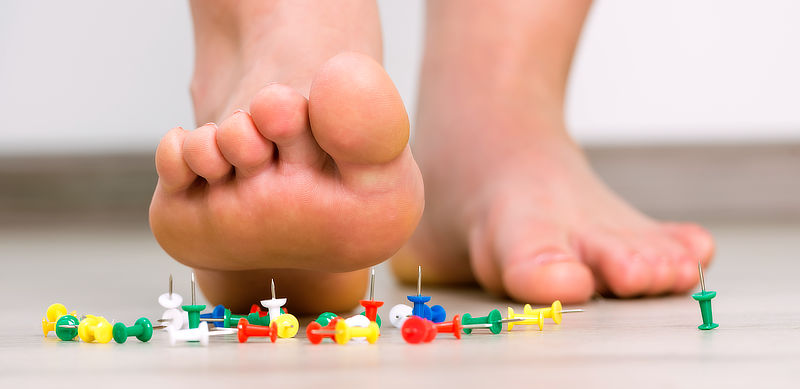
Plantar fasciitis is a type of repetitive strain injury. People who are most likely to suffer from this condition are runners, hikers, and those whose job requires them to stands for long periods of time on hard surfaces (cashiers, for instance). This type of prolonged standing or strain can cause the thick and hard band of tissue that supports the arch of the foot to become damaged or inflamed and that can result in pain and inability to move the foot properly.
So, the main sign that one suffers from this condition is causes foot arch pain and/or heel pain. The pain is usually very strong in the morning. For the purpose of clarification, I must mention that plantar fasciitis should not be confused with conditions such as heel spurs and flat feet – there are certain similarities, but they are not the same at all with plantar fasciitis being a more serious interference with one's well-being.
If you suffer from this condition, the good news is that research shows that many people bounce back from this painful experience with a little rest, however it has to be accompanied with a few other helpful aspects such as regular stretching and wearing proper shoes. There are, however, some severe cases which can inconvenience someone for years and have an impact on the overall health.
A person can also be more prone to developing this condition if they wear inappropriate footwear often, if they have a very high arch, if they are overweight, if they are over the age of 40 and still quite active, if someone starts a demanding physical activity with a lot of intensity all at once, if a person cannot easily flex their feet and in case a person has a disease such as Arthritis.

Luckily, there is a special range of men's and women's plantar fasciitis shoes which are especially designed to help reduce the inflammation and pain. In fact, one of the first treatment options doctors suggest is switching to proper shoes that are made to tackle plantar fasciitis. The specially desgined type of men's and women's plantar fasciitis shoes can greatly lower the pain level and speed up the recovery process.
That being said, you might be wondering what exact features make for the right footwear for this condition. Well, first of all such footwear should ideally feature dual memory foam layer as to increase the level of comfort and joint support. This will result in proper protection of the vertebrae from everyday impact. Also, look for buckle straps that go across the instep and which can be adjusted for a customized fit. This will simultaneously keep the foot stable, while preventing it from slipping out of the front of the shoe. Lightweight sole that's contoured for traction is also something that can add to the comfort level.

Regarding proper arch support, people with this condition should look for shoes for plantar fasciitis women or men design with anatomical arch support that's located at the correct position - under the arch. This can help relieve pain by offering enough support to the foot while reducing overpronation. Less overpronation will naturally lead to less tension on the fascia. Also, the shoes should have a deep heel cup that would feel like a hug around the heel thus protecting the heel bone and controlling pronation and supination.
Types of shoes that people with this condition should never wear are ones that are either too stiff or too unstructured. The wearer should be able to easily twist and bend the foot in the proper type of footwear. A wide toe box design would make for an ideal choice as it can ensure that the toes are not cramped – this must be avoided as it can exacerbate foot pain. Extra depth is also a desired design feature that can tackle this issue.
As mentioned briefly above, stretching is highly recommended on a daily basis if one want to get rid of plantar fasciitis faster and ease the pain in the heel and the foot as a whole. Finally, certain anti-inflammatory drugs (Nonsteroidal - NSAID) such as aspirin and ibuprofen can be of help when it come to reducing inflammation and numbing the pain. Icing the sore area is another method that works well. For best results, the icing should last for 15 minutes and then be followed by stretching.
Comments
Post a Comment